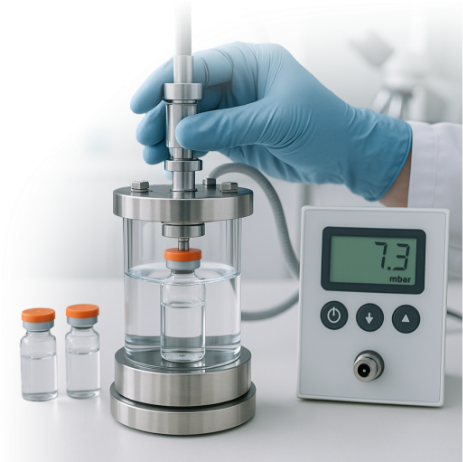Ensuring Sterility, Compliance, and Product Safety
At Solvias, we help safeguard your parenteral products from contamination, ensuring that every container closure system (CCS) maintains its integrity throughout its lifecycle. Our Container Closure Integrity Testing (CCIT) services provide deterministic and probabilistic testing solutions that meet the highest regulatory and quality standards — ensuring product sterility, stability, and patient safety.

Our Expertise in Deterministic and Probabilistic Methods
We offer a full suite of non-destructive and destructive CCIT techniques that align with USP <1207>, EU GMP Annex 1, ICH Q5C, and PDA Technical Report 27 recommendations. Our experts help you select, validate, and optimize the right testing method based on your product type, lifecycle stage, and regulatory needs.
Non-Destructive (Deterministic) Methods
-
Vacuum Decay: Detects leaks by monitoring pressure changes after vacuum application, ideal for lyophilized or empty containers.
-
Pressure Decay: Monitors pressure loss after pressurization, suitable for cytotoxic or pressurized products.
Destructive (Probabilistic) Methods
-
Dye Ingress Test: A cost-effective screening method for liquid-filled products.
-
Microbial Ingress Test: Assesses the ability of closures to prevent microbial contamination, typically used for high-risk or early development validation
Vacuum Decay: The Gold Standard
Among our most in-demand services is vacuum decay testing, a deterministic method offering high sensitivity and automation. This non-destructive technique delivers fast, repeatable, and quantitative results — suitable for both lyophilized and liquid formulations. With multi-chamber instruments, we enable efficient testing across multiple product formats, balancing precision with cost-effectiveness.
Validation and Compliance Built In
Our approach to CCIT validation ensures accuracy, reproducibility, and robustness — meeting the expectations of regulatory bodies worldwide. We define acceptance criteria aligned with your product’s critical quality attributes, perform sensitivity testing, and document every step for regulatory readiness.
Each method is optimized for:
- Sensitivity and reproducibility — detecting even submicron leaks
- System suitability testing (SST) — confirming each setup performs reliably
- Regulatory audit readiness — complete traceability and documentation

Contact us for a complimentary consultation



